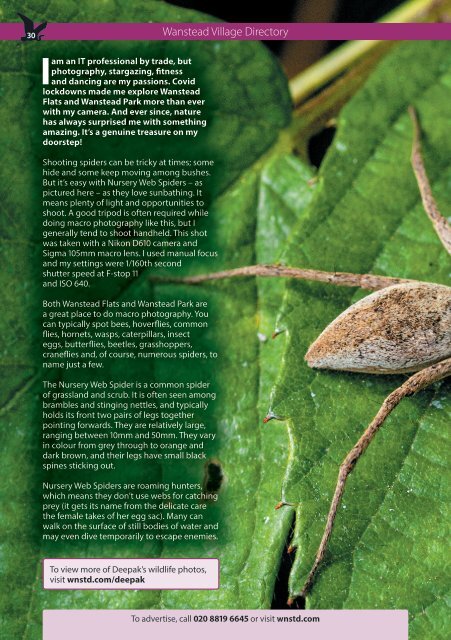February 2024
Create successful ePaper yourself
Turn your PDF publications into a flip-book with our unique Google optimized e-Paper software.
30<br />
Wanstead Village Directory<br />
I<br />
am an IT professional by trade, but<br />
photography, stargazing, fitness<br />
and dancing are my passions. Covid<br />
lockdowns made me explore Wanstead<br />
Flats and Wanstead Park more than ever<br />
with my camera. And ever since, nature<br />
has always surprised me with something<br />
amazing. It’s a genuine treasure on my<br />
doorstep!<br />
Shooting spiders can be tricky at times; some<br />
hide and some keep moving among bushes.<br />
But it’s easy with Nursery Web Spiders – as<br />
pictured here – as they love sunbathing. It<br />
means plenty of light and opportunities to<br />
shoot. A good tripod is often required while<br />
doing macro photography like this, but I<br />
generally tend to shoot handheld. This shot<br />
was taken with a Nikon D610 camera and<br />
Sigma 105mm macro lens. I used manual focus<br />
and my settings were 1/160th second<br />
shutter speed at F-stop 11<br />
and ISO 640.<br />
Both Wanstead Flats and Wanstead Park are<br />
a great place to do macro photography. You<br />
can typically spot bees, hoverflies, common<br />
flies, hornets, wasps, caterpillars, insect<br />
eggs, butterflies, beetles, grasshoppers,<br />
craneflies and, of course, numerous spiders, to<br />
name just a few.<br />
The Nursery Web Spider is a common spider<br />
of grassland and scrub. It is often seen among<br />
brambles and stinging nettles, and typically<br />
holds its front two pairs of legs together<br />
pointing forwards. They are relatively large,<br />
ranging between 10mm and 50mm. They vary<br />
in colour from grey through to orange and<br />
dark brown, and their legs have small black<br />
spines sticking out.<br />
Nursery Web Spiders are roaming hunters,<br />
which means they don’t use webs for catching<br />
prey (it gets its name from the delicate care<br />
the female takes of her egg sac). Many can<br />
walk on the surface of still bodies of water and<br />
may even dive temporarily to escape enemies.<br />
To view more of Deepak’s wildlife photos,<br />
visit wnstd.com/deepak<br />
To advertise, call 020 8819 6645 or visit wnstd.com
















